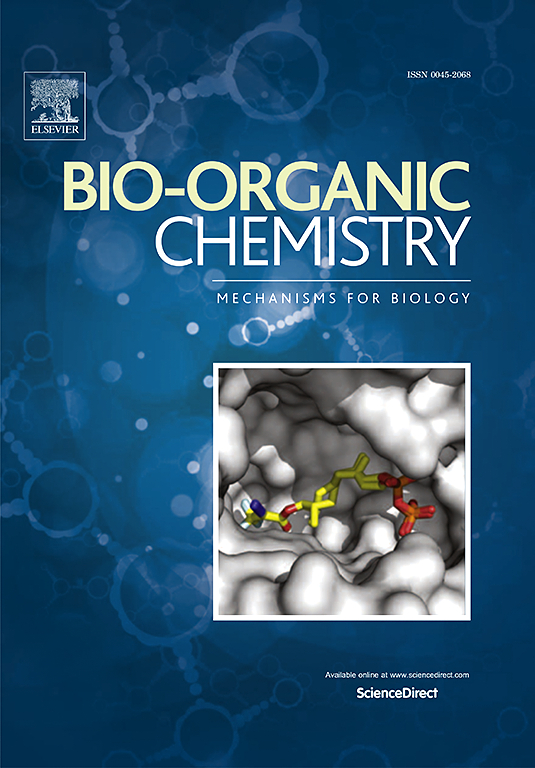Peptidomimetics based on thiacalixarene with L-tyrosine moieties: Antibacterial activity against methicillin-resistant Staphylococcus aureus and degradation induced by binding to α-chymotrypsin
IF 4.5
2区 医学
Q1 BIOCHEMISTRY & MOLECULAR BIOLOGY
引用次数: 0
Abstract
The design of new antimicrobial agents is an important challenge due to the growing resistance of microorganisms to existing antibiotics. In recent years, the trend towards the development of compounds and materials with (bio)degradable properties has emerged. In this work, we propose and develop a method for the synthesis of new peptidomimetics, i.e., water-soluble macrocyclic quaternary ammonium salts containing L-tyrosine fragments based on p-tert-butylthiacalix[4]arene in various stereoisomeric forms (cone, partial cone, and 1,3-alternate). These compounds have low cytotoxicity (IC50 = 80–267 μM) and high antibacterial activity (MIC = 0.5–15.6 μM) against Gram-positive bacterial strains including methicillin-resistant Staphylococcus aureus (MRSA). The obtained peptidomimetics can bind α-chymotrypsin with the formation of supramolecular systems and their subsequent degradation. Our results demonstrate the first example of multi-action thiacalixarene derivatives with antibacterial activity, protein binding ability and degradation induced by binding to α-chymotrypsin. The obtained results open the possibility of creating multi-action peptidomimetic systems with antimicrobial and biodegradable effect.

含l -酪氨酸部分的硫叉芳烃类肽:对耐甲氧西林金黄色葡萄球菌的抗菌活性及与α-凝乳胰蛋白酶结合诱导的降解
由于微生物对现有抗生素的耐药性日益增加,新的抗菌剂的设计是一个重要的挑战。近年来,具有(生物)可降解性能的化合物和材料的发展趋势已经出现。在这项工作中,我们提出并发展了一种合成新的肽模拟物的方法,即基于对叔丁基thiacalix[4]芳烃以各种立体异构体形式(锥形,部分锥形和1,3-交替)合成含有l -酪氨酸片段的水溶性大环季铵盐。这些化合物对革兰氏阳性细菌(包括耐甲氧西林金黄色葡萄球菌(MRSA))具有低细胞毒性(IC50 = 80 ~ 267 μM)和高抑菌活性(MIC = 0.5 ~ 15.6 μM)。所得的拟肽物可以结合α-凝乳胰蛋白酶,形成超分子体系并随后降解。我们的研究结果首次证明了多作用噻烷芳烃衍生物具有抗菌活性、蛋白质结合能力和与α-凝乳胰蛋白酶结合引起的降解。所获得的结果为创造具有抗菌和生物降解作用的多作用拟肽系统提供了可能性。
本文章由计算机程序翻译,如有差异,请以英文原文为准。
求助全文
约1分钟内获得全文
求助全文
来源期刊

Bioorganic Chemistry
生物-生化与分子生物学
CiteScore
9.70
自引率
3.90%
发文量
679
审稿时长
31 days
期刊介绍:
Bioorganic Chemistry publishes research that addresses biological questions at the molecular level, using organic chemistry and principles of physical organic chemistry. The scope of the journal covers a range of topics at the organic chemistry-biology interface, including: enzyme catalysis, biotransformation and enzyme inhibition; nucleic acids chemistry; medicinal chemistry; natural product chemistry, natural product synthesis and natural product biosynthesis; antimicrobial agents; lipid and peptide chemistry; biophysical chemistry; biological probes; bio-orthogonal chemistry and biomimetic chemistry.
For manuscripts dealing with synthetic bioactive compounds, the Journal requires that the molecular target of the compounds described must be known, and must be demonstrated experimentally in the manuscript. For studies involving natural products, if the molecular target is unknown, some data beyond simple cell-based toxicity studies to provide insight into the mechanism of action is required. Studies supported by molecular docking are welcome, but must be supported by experimental data. The Journal does not consider manuscripts that are purely theoretical or computational in nature.
The Journal publishes regular articles, short communications and reviews. Reviews are normally invited by Editors or Editorial Board members. Authors of unsolicited reviews should first contact an Editor or Editorial Board member to determine whether the proposed article is within the scope of the Journal.
 求助内容:
求助内容: 应助结果提醒方式:
应助结果提醒方式:


